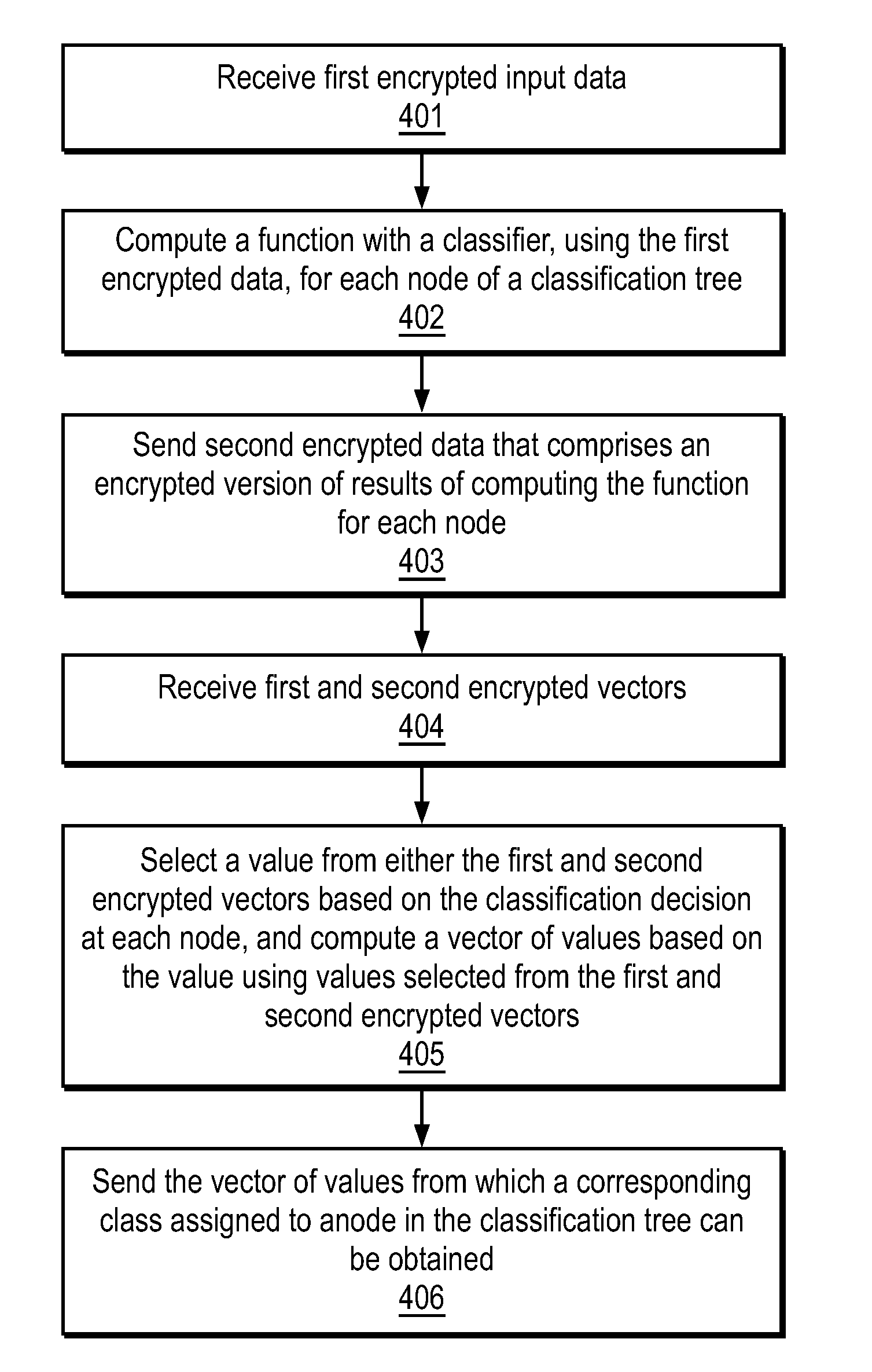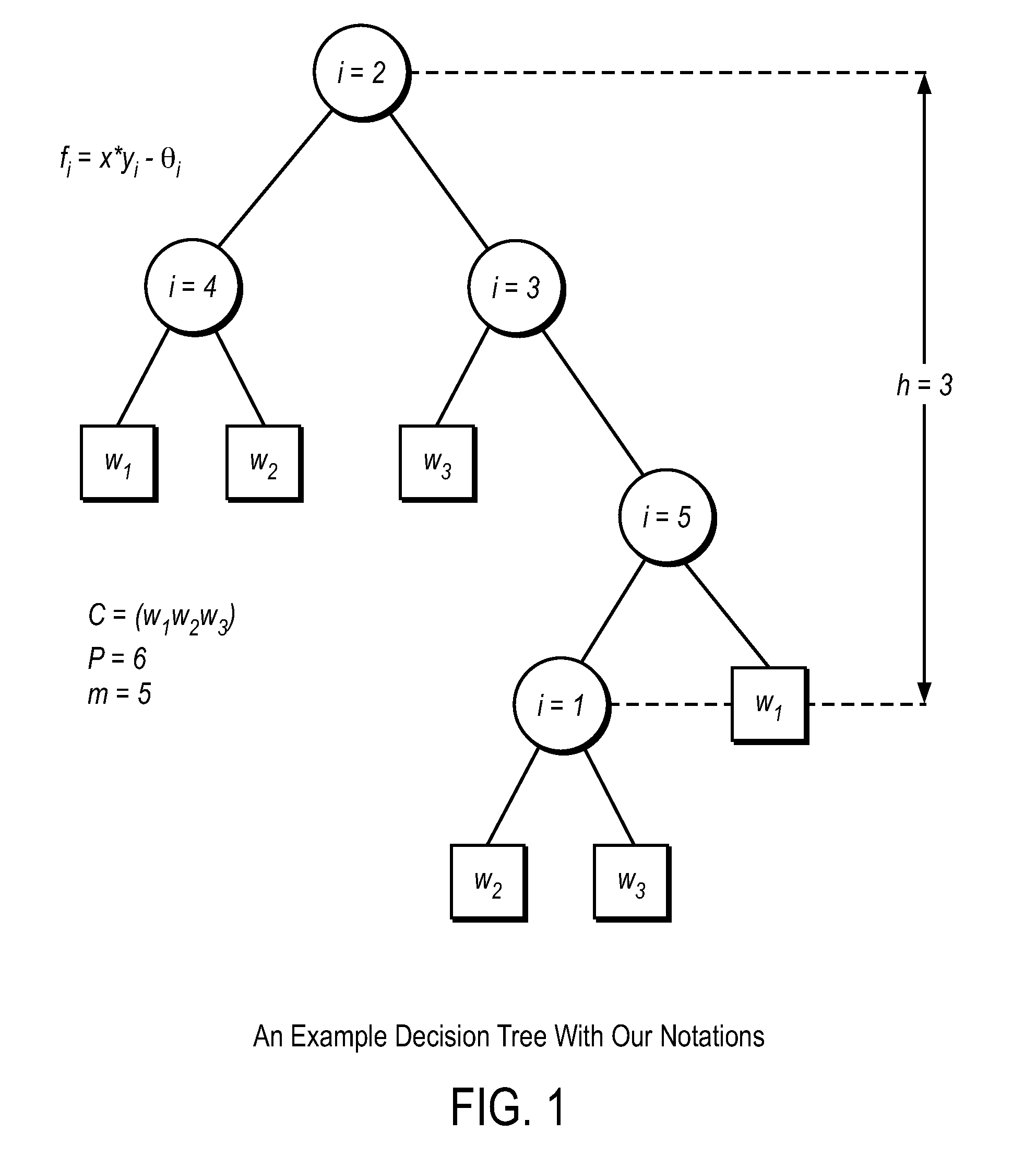Efficient, remote, private tree-based classification using cryptographic techniques
a cryptographic technique and private tree technology, applied in the field of classification and their use, can solve the problems of user inability to run a classification algorithm, inability to secure input data, and inability to communicate with users,
- Summary
- Abstract
- Description
- Claims
- Application Information
AI Technical Summary
Problems solved by technology
Method used
Image
Examples
example 1
Detailed Example 1
OPE and One Splitting Rule Evaluation
[0115]The following are the parameters. The objective is to obliviously evaluate the satisfiability of a split at a node in the classification tree.
[0116]p=383 (a 9-bit prime)
[0117]g=379 (a generator of the multiplicative cyclic group *383)
[0118]q=128 (For the comparison protocol to work, q [0119]ƒ(x)=5x (The degree d=1) [0120]Let's assume the user has the value x=3 and the classifier's threshold value θ=10. Note that the threshold is based on the design of the classifier, which is standard in the art. The objective of the protocol is for the user to know the value (sign) of ƒ(x)−θ without letting the classifier know either the output or the input. Without the OPE protocol, the answer is 5·3−10=5. [0121]The user computes the following matrix V (in this case, it is a vector, as the degree of ƒ is 1) where v(i,j)=2j-1·vi, with i being the exponent and j being the bit position, that is, V=(20·321·322·323...
example 2
Detailed Example 2
OPE and One Splitting Rule Evaluation
[0127]Everything in the detailed example 1 except the x value of the user remains unchanged for this example. Here, let x=1.
[0128]The user computes the following values:
V=(1 2 4 8 16 32 64),
R=(13 11 2 13 5 4 1).
[0129]The classifier gets the following values:
M=(1+13 11 4+2 13 5 4 1)
[0130]The classifier computes Σmij=54 and sends the value os=54−10=44. The user computes os−Σrij=44−49=−5=378 and decides that it does not satisfy the splitting rule ƒ(x)>θ (since 378>128).
example 3
Detailed Example 3
OPE and One Splitting Rule Evaluation (Higher Degree)
[0131]Everything in the detailed example 1 except the function ƒ(x) remains unchanged for this example. Let ƒ(x)=5x+2x2 (d=2). All the above examples use degree-1 polynomials; here, however, a degree-2 polynomial is used in this example. One can trivially extend this to higher degree polynomials.
[0132]The user computes the following:
V=(36122448961929183672144288576),R=(81736216437543).
[0133]The classifier gets the following values through OT12 protocols:
M=(3+8112+73621618+437543)
[0134]The classifier computes Σi,jmij=54 and sends the value os=93−10=83. The user computes os−Σr(i,j)=83−60=33 and decides that it satisfies the splitting rule ƒ(x)>θ (since 33<128).
[0135]Note that the value 83 does not indicate anything about the satisfiability to the classifier. For example, the sum of random values can be greater than the output of the classifier and in this case, the user's input does not satisfy the splitting rule e...
PUM
 Login to View More
Login to View More Abstract
Description
Claims
Application Information
 Login to View More
Login to View More - R&D
- Intellectual Property
- Life Sciences
- Materials
- Tech Scout
- Unparalleled Data Quality
- Higher Quality Content
- 60% Fewer Hallucinations
Browse by: Latest US Patents, China's latest patents, Technical Efficacy Thesaurus, Application Domain, Technology Topic, Popular Technical Reports.
© 2025 PatSnap. All rights reserved.Legal|Privacy policy|Modern Slavery Act Transparency Statement|Sitemap|About US| Contact US: help@patsnap.com



